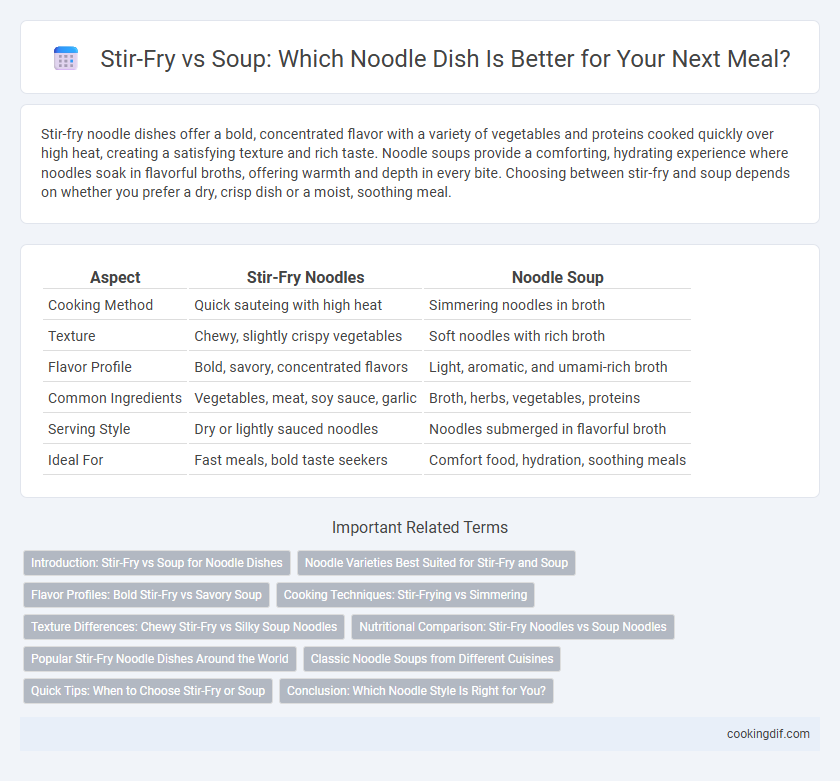Stir-fry noodle dishes offer a bold, concentrated flavor with a variety of vegetables and proteins cooked quickly over high heat, creating a satisfying texture and rich taste. Noodle soups provide a comforting, hydrating experience where noodles soak in flavorful broths, offering warmth and depth in every bite. Choosing between stir-fry and soup depends on whether you prefer a dry, crisp dish or a moist, soothing meal.
Table of Comparison
| Aspect | Stir-Fry Noodles | Noodle Soup |
|---|---|---|
| Cooking Method | Quick sauteing with high heat | Simmering noodles in broth |
| Texture | Chewy, slightly crispy vegetables | Soft noodles with rich broth |
| Flavor Profile | Bold, savory, concentrated flavors | Light, aromatic, and umami-rich broth |
| Common Ingredients | Vegetables, meat, soy sauce, garlic | Broth, herbs, vegetables, proteins |
| Serving Style | Dry or lightly sauced noodles | Noodles submerged in flavorful broth |
| Ideal For | Fast meals, bold taste seekers | Comfort food, hydration, soothing meals |
Introduction: Stir-Fry vs Soup for Noodle Dishes
Stir-fry noodle dishes typically feature quick-cooked noodles tossed with vegetables, proteins, and sauces, creating a savory, concentrated flavor profile. Soup-based noodle dishes immerse noodles in rich broths combined with aromatic spices and fresh ingredients, offering a comforting and hydrating experience. Both methods highlight the versatility of noodles, catering to diverse textures and taste preferences in global cuisine.
Noodle Varieties Best Suited for Stir-Fry and Soup
Wheat-based noodles like lo mein, chow mein, and udon are best suited for stir-fry dishes due to their firm texture and ability to absorb savory sauces without becoming mushy. In contrast, rice noodles such as pho or pad thai noodles excel in soup preparations because they soften quickly and complement light, flavorful broths. Egg noodles work well in both stir-fry and soup, offering a chewy bite that holds up in diverse cooking methods.
Flavor Profiles: Bold Stir-Fry vs Savory Soup
Stir-fry noodle dishes deliver bold, intense flavors through high-heat cooking and concentrated sauces like soy, oyster, and chili, creating layers of umami and spice. In contrast, noodle soups offer a savory, comforting profile with rich broths infused with ingredients such as bone marrow, ginger, and herbs, emphasizing depth and balance. Both methods highlight distinct taste experiences, with stir-fry focusing on robust, punchy elements and soup emphasizing warm, nuanced savoriness.
Cooking Techniques: Stir-Frying vs Simmering
Stir-frying noodles involves quickly cooking them over high heat with minimal oil, which preserves their texture and imparts a slightly charred, smoky flavor through Maillard reaction. Simmering noodles in soup requires gentle, prolonged heat that allows noodles to absorb broth flavors and soften evenly, resulting in a comforting, tender dish. The choice between stir-frying and simmering directly affects noodle texture, flavor integration, and overall dish complexity.
Texture Differences: Chewy Stir-Fry vs Silky Soup Noodles
Stir-fry noodles boast a chewy texture due to high-heat cooking that caramelizes the surface, creating a satisfying bite and slight crispness. In contrast, soup noodles offer a silky, smooth mouthfeel as they absorb broth flavors and soften without losing elasticity. The choice between the two hinges on whether you prefer a hearty, textured experience or a delicate, comforting noodle dish.
Nutritional Comparison: Stir-Fry Noodles vs Soup Noodles
Stir-fry noodles typically contain higher calorie and fat content due to the use of oils and sauces, offering a more energy-dense meal rich in protein and vegetables. Soup noodles provide a hydrating, lower-calorie option, often with a nutrient-rich broth that can include vitamins and minerals from simmered bones, vegetables, or seaweed. Both dishes contribute valuable nutrients, but stir-fry noodles tend to be more filling and nutrient-concentrated, while soup noodles support hydration and lighter digestion.
Popular Stir-Fry Noodle Dishes Around the World
Stir-fry noodle dishes such as Pad Thai from Thailand, Chow Mein from China, and Yakisoba from Japan showcase a vibrant mix of vegetables, proteins, and sauces cooked over high heat for a flavorful and quick meal. These dishes emphasize texture and bold seasoning, often incorporating soy sauce, oyster sauce, or tamarind paste to elevate the noodle's taste. Stir-fried noodles offer a versatile culinary experience, contrasting with noodle soups by providing a drier, more concentrated flavor profile cherished across various Asian cuisines.
Classic Noodle Soups from Different Cuisines
Classic noodle soups across various cuisines showcase rich broths infused with herbs, spices, and proteins that highlight regional flavors, such as Japanese ramen's savory pork-based broth, Vietnamese pho's aromatic beef stock, and Thai boat noodles' spiced herbal soup. These noodle soups emphasize a balance of textures and temperatures, combining tender noodles with vibrant, flavorful liquids that enhance the eating experience. Compared to stir-fried noodles, noodle soups deliver moisture and depth through their complex, slow-simmered broths, making them a comforting and aromatic staple in global culinary traditions.
Quick Tips: When to Choose Stir-Fry or Soup
Stir-fry noodle dishes work best for quick, high-heat cooking with minimal liquid, preserving the noodles' texture and delivering bold, concentrated flavors. Soup noodle dishes excel when you want a comforting, hydrating meal with rich broth that infuses noodles with complex aromas and moisture. Choose stir-fry for fast, crispy meals and opt for soup when craving warmth and savory depth in every spoonful.
Conclusion: Which Noodle Style Is Right for You?
Stir-fry noodles offer a bold, savory experience with crisp vegetables and rich sauces, ideal for those seeking a quick, flavorful meal. Soup noodles provide a comforting, warm option featuring broth-infused ingredients that soothe and hydrate, perfect for cold weather or light dining. Your choice depends on craving intensity, texture preference, and meal occasion, making both stir-fry and soup noodles versatile staples in global cuisine.
Stir-fry vs soup for noodle dishes Infographic

 cookingdif.com
cookingdif.com